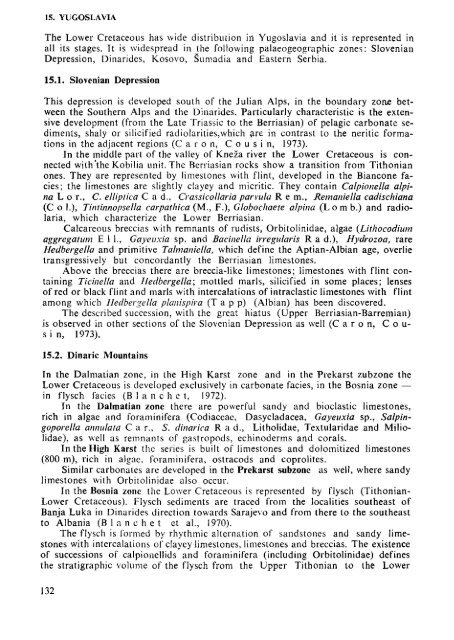THE MEDITERRANEAN LOWER CRETACEOUS
THE MEDITERRANEAN LOWER CRETACEOUS
THE MEDITERRANEAN LOWER CRETACEOUS
Create successful ePaper yourself
Turn your PDF publications into a flip-book with our unique Google optimized e-Paper software.
15. YUGOSLAVIA<br />
The Lower Cretaceous has wide distribution in Yugoslavia and it is represented in<br />
all its stages. It is widespread in the following palaeogeographic zones: Slovenian<br />
Depression, Dinarides, Kosovo, Sumadia and Eastern Serbia.<br />
15.1. Slovenian Depression<br />
This depression is developed south of the Julian Alps, in the boundary zone between<br />
the Southern Alps and the Dinarides. Particularly characteristic is the extensive<br />
development (from the Late Triassic to the Berriasian) of pelagic carbonate sediments,<br />
shaly or silicified radiolarities,which are in contrast to the neritic formations<br />
in the adjacent regions (С a г о n, Cousin, 1973).<br />
In the middle part of the valiey of Kneza river the Lower Cretaceous is connected<br />
with'the Kobilia unit. The Berriasian rocks show a transition from Tithonian<br />
ones. They are represented by limestones with flint, developed in the Biancone facies;<br />
the limestones are slightly clayey and micritic. They contain Calpionella alpina<br />
L о г., С. elliptica С a d., Crassicollaria parvula R e m., Remaniella cadischiana<br />
(С о 1.), Tintinnopsella carpathica (ML, F.), Globochaeie alpina (Lomb.) and radiolaria,<br />
which characterize the Lower Berriasian.<br />
Calcareous breccias with remnants of rudists, Orbitolinidae, algae (Lithocodium<br />
aggregation E 1 1., Gayeuxia sp. and Bacinella irregularis R a d.), Hydrozoa, rare<br />
Hedbergella and primitive Talmaniella, which define the Aptian-Albian age, overlie<br />
transgressively but concordantly the Berriasian limestones.<br />
Above the breccias there are breccia-like limestones; limestones with flint containing<br />
Ticinella and Hedbergella; mottled marls, silicified in some places; lenses<br />
of red or black flint and marls with intercalations of intraclastic limestones with flint<br />
among which Hedbergella planispira (T a p p) (Albian) has been discovered.<br />
The described succession, with the great hiatus (Upper Berriasian-Barremian)<br />
is observed in other sections of the Slovenian Depression as well (С a r о n, Cous<br />
i n, 1973).<br />
15.2. Dinaric Mountains<br />
In the Dalmatian zone, in the High Karst zone and in the Prekarst zubzone the<br />
Lower Cretaceous is developed exclusively in carbonate facies, in the Bosnia zone —<br />
in flysch facies (B 1 a n с h e t, 1972).<br />
In the Dalmatian zone there are powerful sandy and bioclastic limestones,<br />
rich in algae and foraminifera (Codiaceae, Dasycladacea, Gayeuxia sp., Salpingoporella<br />
annula/a С а г., S. dinarica R a d., Litholidae, Textularidae and Miliolidae),<br />
as well as remnants of gastropods, echinoderms and corals.<br />
In the High Karst the series is built of limestones and dolomitized limestones<br />
(800 m), rich in algae, foraminifera, ostracods and coprolites.<br />
Similar carbonates are developed in the Prekarst subzonc as well, where sandy<br />
limestones with Orbitolinidae also occur.<br />
In the Bosnia zone the Lower Cretaceous is represented by flysch (Tithonian-<br />
Lower Cretaceous). Flysch sediments are traced from the localities southeast of<br />
Banja Luka in Dinarides direction towards Sarajevo and from there to the southeast<br />
to Albania (В 1 a n с h e t et al., 1970).<br />
The flysch is formed by rhythmic alternation of sandstones and sandy limestones<br />
with intercalations of clayey limestones, limestones and breccias. The existence<br />
of successions of calpionellids and foraminifera (including Orbitolinidae) defines<br />
the stratigraphie volume of the flysch from the Upper Tithonian to the Lower<br />
132

















